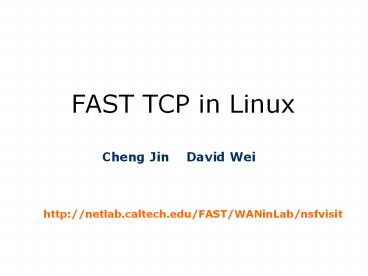FAST TCP in Linux - PowerPoint PPT Presentation
1 / 26
Title:
FAST TCP in Linux
Description:
FAST TCP in Linux Cheng Jin David Wei http://netlab.caltech.edu/FAST/WANinLab/nsfvisit – PowerPoint PPT presentation
Number of Views:70
Avg rating:3.0/5.0
Title: FAST TCP in Linux
1
FAST TCP in Linux
- Cheng Jin David Wei
- http//netlab.caltech.edu/FAST/WANinLab/nsfv
isit
2
Outline
- Overview of FAST TCP.
- Implementation Details.
- SC2002 Experiment Results.
- FAST Evaluation and WAN-in-Lab.
3
FAST vs. Linux TCP
Distance 10,037 km Delay 180 ms MTU 1500
B Duration 3600 s Linux TCP Experiments Jan
28-29, 2003
4
Aggregate Throughput
92
- FAST
- Standard MTU
- Utilization averaged over 1hr
2G
48
Average utilization
95
1G
27
16
19
txq100
txq10000
Linux TCP Linux TCP FAST
Linux TCP Linux TCP FAST
5
Summary of Changes
- RTT estimation fine-grain timer.
- Fast convergence to equilibrium.
- Delay monitoring in equilibrium.
- Pacing reducing burstiness.
6
FAST TCP Flow Chart
Fast Convergence
Slow Start
Normal Recovery
Equilibrium
Time-out
Loss Recovery
7
RTT Estimation
- Measure queueing delay.
- Kernel timestamp with ?s resolution.
- Use SACK to increase the number of RTT samples
during recovery. - Exponential averaging of RTT samples to increase
robustness.
8
Fast Convergence
- Rapidly increase or decrease cwnd toward
equilibrium. - Monitor the per-ack queueing delay to avoid
overshoot.
9
Equilibrium
- Vegas-like cwnd adjustment in large time-scale --
per RTT. - Small step-size to maintain stability in
equilibrium. - Per-ack delay monitoring to enable timely
detection of changes in equilibrium.
10
Pacing
- What do we pace?
- Increment to cwnd.
- Time-Driven vs. event-driven.
- Trade-off between complexity and performance.
- Timer resolution is important.
11
Time-Based Pacing
data
ack
data
cwnd increments are scheduled at fixed
intervals.
12
Event-Based Pacing
Detect sufficiently large gap between consecutive
bursts and delay cwnd increment until the end of
each such burst.
13
SCinet Caltech-SLAC experiments
SC2002 Baltimore, Nov 2002
Highlights
- FAST TCP
- Standard MTU
- Peak window 14,255 pkts
- Throughput averaged over gt 1hr
- 925 Mbps single flow/GE card
- 9.28 petabit-meter/sec
- 1.89 times LSR
- 8.6 Gbps with 10 flows
- 34.0 petabit-meter/sec
- 6.32 times LSR
- 21TB in 6 hours with 10 flows
- Implementation
- Sender-side modification
- Delay based
10
9
Geneva-Sunnyvale
7
flows
FAST
2
Baltimore-Sunnyvale
1
2
1
I2 LSR
netlab.caltech.edu/FAST
C. Jin, D. Wei, S. Low FAST Team and Partners
14
Network
(Sylvain Ravot, caltech/CERN)
15
FAST BMPS
10
flows
9
Geneva-Sunnyvale
7
FAST
2
Baltimore-Sunnyvale
1
- FAST
- Standard MTU
- Throughput averaged over gt 1hr
Internet2 Land Speed Record
1
2
16
Aggregate Throughput
88
- FAST
- Standard MTU
- Utilization averaged over gt 1hr
90
90
Average utilization
92
95
1.1hr
6hr
6hr
1hr
1hr
1 flow 2 flows
7 flows 9 flows
10 flows
17
Caltech-SLAC Entry
Rapid recovery after possible hardware glitch
Power glitch Reboot
100-200Mbps ACK traffic
18
SCinet Caltech-SLAC experiments
SC2002 Baltimore, Nov 2002
Acknowledgments
netlab.caltech.edu/FAST
- Prototype
- C. Jin, D. Wei
- Theory
- D. Choe (Postech/Caltech), J. Doyle, S. Low, F.
Paganini (UCLA), J. Wang, Z. Wang (UCLA) - Experiment/facilities
- Caltech J. Bunn, C. Chapman, C. Hu
(Williams/Caltech), H. Newman, J. Pool, S. Ravot
(Caltech/CERN), S. Singh - CERN O. Martin, P. Moroni
- Cisco B. Aiken, V. Doraiswami, R. Sepulveda, M.
Turzanski, D. Walsten, S. Yip - DataTAG E. Martelli, J. P. Martin-Flatin
- Internet2 G. Almes, S. Corbato
- Level(3) P. Fernes, R. Struble
- SCinet G. Goddard, J. Patton
- SLAC G. Buhrmaster, R. Les Cottrell, C. Logg, I.
Mei, W. Matthews, R. Mount, J. Navratil, J.
Williams - StarLight T. deFanti, L. Winkler
- TeraGrid L. Winkler
- Major sponsors
19
Evaluating FAST
- End-to-End monitoring doesnt tell the whole
story. - Existing network emulation (dummynet) is not
always enough. - Better optimization if we can look inside and
understand the real network.
20
Dummynet and Real Testbed
21
Dummynet Issues
- Not running on a real-time OS -- imprecise
timing. - Lack of priority scheduling of dummynet events.
- Bandwidth fluctuates significantly with workload.
- Much work needed to customize dummynet for
protocol testing.
22
10 GbE Experiment
- Long-distance testing of Intel 10GbE cards.
- Sylvain Ravot (Caltech) achieved 2.3 Gbps using
single stream with jumbo frame and stock Linux
TCP. - Tested HSTCP, Scalable TCP, FAST, and stock TCP
under Linux.
1500B MTU 1.3 Gbps SNV -gt CHI 9000B MTU 2.3
Gbps SNV -gt GVA
23
TCP Loss Mystery
- Frequent packet loss with 1500-byte MTU. None
with larger MTUs. - Packet loss even when cwnd is capped at 300 - 500
packets. - Routers have large queue size of 4000 packets.
- Packets captured at both sender and receiver
using tcpdump.
24
How Did the Loss Happen?
loss detected
25
How Can WAN-in-Lab Help?
- We will know exactly where packets are lost.
- We will also know the sequence of events (packet
arrivals) that lead to loss. - We can either fix the problem in the network if
any, or improve the protocol.
26
Conclusion
- FAST improves the end-to-end performance of TCP.
- Many issues are still to be understood and
resolved. - WAN-in-Lab can help make FAST a better protocol.

